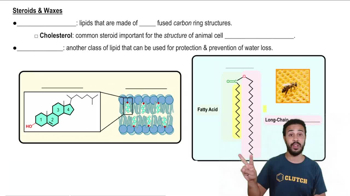Here are the essential concepts you must grasp in order to answer the question correctly.
Monosaccharides
Monosaccharides are the simplest form of carbohydrates, consisting of single sugar molecules like glucose and fructose. They serve as fundamental building blocks for more complex carbohydrates and are primarily involved in energy production and storage in living organisms.
Recommended video:
Formation & Breakdown of Polysaccharides
Lipids
Lipids are a diverse group of hydrophobic organic molecules, including fats, phospholipids, and steroids. They play crucial roles in energy storage, cellular structure, and signaling within biological systems. Unlike carbohydrates, lipids do not dissolve in water, which is a key characteristic.
Recommended video:
Phospholipids, Fats, and Steroids
Phospholipids, fats, and steroids are all types of lipids. Phospholipids are essential for forming cell membranes, fats are primarily used for energy storage, and steroids serve various functions, including acting as hormones. In contrast, monosaccharides do not belong to the lipid category, making them distinct from the other terms listed.
Recommended video:






